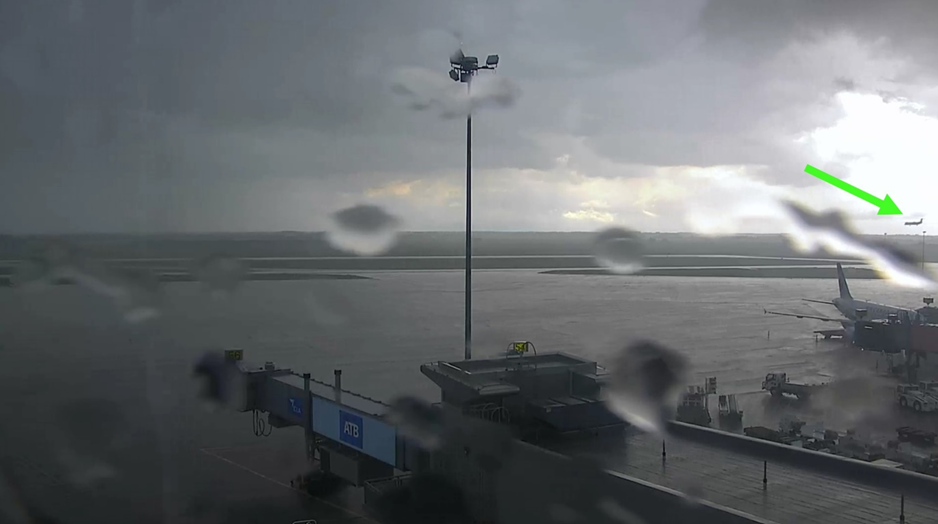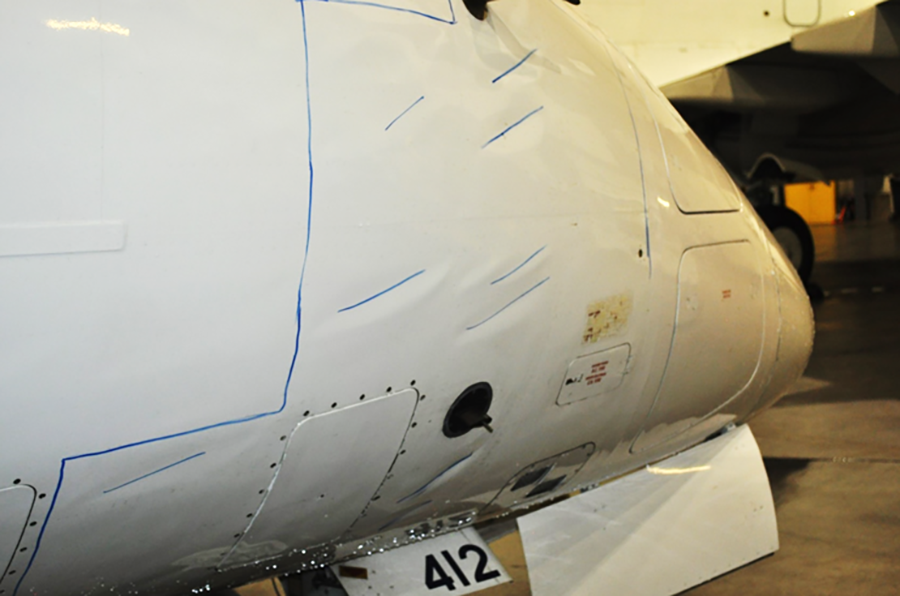Hard landing
WestJet Encore Ltd.
Bombardier DHC-8-402, C-FKWE
Edmonton International Airport, Alberta
The Transportation Safety Board of Canada (TSB) investigated this occurrence for the purpose of advancing transportation safety. It is not the function of the Board to assign fault or determine civil or criminal liability. This report is not created for use in the context of legal, disciplinary or other proceedings. See Ownership and use of content. Masculine pronouns and position titles may be used to signify all genders to comply with the Canadian Transportation Accident Investigation and Safety Board Act (S.C. 1989, c. 3).
History of the flight
At 1618Footnote 1 on 19 July 2019, a WestJet Encore Ltd. Bombardier DHC-8-402 aircraft (registration C-FKWE, serial number 4467) operating as scheduled flight 3362 (WEN3362), departed Fort McMurray Airport (CYMM), Alberta, on an instrument flight rules (IFR) flight plan bound for Edmonton International Airport (CYEG), Alberta. On board were 2 flight crew members, 2 cabin crew members and 70 passengers. The captain was the pilot flying (PF) and the first officer was the pilot monitoring (PM). The planned flight time was 1 hour and 2 minutes.
After departure, the aircraft climbed to a cruising altitude of flight level 240.Footnote 2 During the flight, the landing runway was changed from Runway 30 to Runway 20, and finally to Runway 12 because of the weather at CYEG, which included a thunderstorm in the area. Once on final approach for Runway 12, the flight crew was cleared for a visual approach. The PF planned for and briefed the PM on a flap 15 landingFootnote 3 with a VREFFootnote 4 speed of 122 knots indicated airspeed (KIAS). In the event a missed approach would be necessary, the plan was to turn right to a heading of 270° magnetic. This manoeuvre had been approved by the controller.
During the approach phase, the PF added 20 knots to the VREF speed in anticipation of a missed approach, which would involve flying in close proximity to the approaching thunderstorm and possible wind shear. A firm landing was planned due to the potentially gusty conditions on the ground.
When the aircraft was 3 nautical miles from CYEG, in level flight at 5000 feet above sea level, the flaps were set to 15°, the landing gear was lowered and the aircraft’s airspeed was 142 KIAS, which was the planned VREF speed plus the added 20 knots.
At 1713, the aircraft touched down on the main landing gear within the touchdown zoneFootnote 5 at a speed of 142 KIAS. Shortly after the initial touchdown, the aircraft’s weight on wheels sensor indicated that the aircraft had briefly returned to air mode.Footnote 6 The PF then made a full nose-down elevator input. A bang and a nose-wheel shimmy followed, and the aircraft pulled to the left as it rolled out on the runway.
After landing, the crew consulted the aircraft’s integrated communication and application system, and no hard landing indications were noted. The flight crew then taxied the aircraft off Runway 12 and onto Taxiway A2. Concerned that the aircraft had been damaged during the landing, the flight crew then stopped and requested assistance from maintenance.
Due to lightning activity near the airport, shortly after the aircraft had landed, the CYEG duty manager issued a red alert,Footnote 7 restricting ground handlers and maintenance personnel from accessing the airfield. Approximately 45 minutes later, the red alert was cancelled and WestJet Encore Ltd. maintenance personnel attended to the occurrence aircraft. After a brief damage assessment, both nose landing gear tires were changed and the flight crew taxied the aircraft to the terminal gate to disembark the passengers.
There were no reported injuries.
Weather information
The aerodrome routine meteorological report (METAR) for CYEG at 1700—13 minutes before landing—indicated the following:
- winds 220° true (T) at 8 knots, gusting to 15 knots
- visibility 15 statute miles in light thunderstorms and rain
- broken ceiling of cumulonimbus clouds at 3000 feet above ground level (AGL) and broken layer of clouds at 8300 feet AGL
- temperature 16 °C; dew point 13 °C
- altimeter setting 29.78 inches of mercury
A large thunderstorm cell situated to the northeast of the airport was advancing to the southwest and was over the departure end of Runway 12 as the occurrence aircraft landed (Figure 1).
Flight crew information
Records indicate that the captain and first officer were certified and qualified for the flight in accordance with existing regulations.
The captain held an airline transport pilot licence – aeroplane and a valid Category 1 medical certificate. He had accumulated over 5234 hours total flight time, including 1748 hours on type.
The first officer held a commercial pilot licence – aeroplane, with multi-engine and Group 1 instrument ratings, and a valid Category 1 medical certificate. He had accumulated over 1028 hours total flight time, including 28 hours on type.
Based on a review of the captain’s and the first officer’s work-rest schedules, fatigue was not considered a factor in the occurrence.
Aircraft information
The occurrence aircraft was manufactured in 2014 and was issued its Certificate of Airworthiness the same year. The aircraft was configured to accommodate up to 78 passengers.
The aircraft was certified, equipped and maintained in accordance with WestJet Encore Ltd.’s maintenance schedule and existing regulations.
Damage to the aircraft
After the passengers deplaned at the gate, WestJet Encore Ltd. maintenance personnel performed a more detailed inspection of the occurrence aircraft, which revealed wrinkled fuselage skins (Figure 2) as well as damage to the left nose-gear door, the forward pressure bulkhead, and the nose-gear assembly.
Flight data recorder information
The aircraft was equipped with a cockpit voice recorder (CVR) and a digital flight data recorder (DFDR), as required by the Canadian Aviation Regulations. The CVR was capable of recording 2 hours, and the DFDR was capable of recording 140 hours.
The aircraft operating manual requires that the CVR circuit breaker be disabled after an incident or accident.Footnote 8 However, because the flight crew did not observe any indications of a hard landing on the aircraft’s integrated communication and application system, the crew did not pull the CVR circuit breakers. Following the tire change, the aircraft taxied to the gate where the DFDR/CVR circuit breakers were pulled by the WestJet Encore technical operations team. This delay resulted in the audio recording of the occurrence being overwritten, and thus in the loss of valuable information to assist the investigation.
The data from the DFDR confirmed that all aircraft systems were operating normally during the occurrence.
The data also indicated that the large nose-down elevator deflection at touchdown resulted in the nose being lowered at approximately 10 degrees per second, compared with 4 degrees per second, which was the highest rate of nose-lowering recorded during prior landings.
Normal procedures
With regards to speed on approach and touchdown techniques, the WestJet Encore Aircraft Operating Manual contains the following guidance:
Fly the approach at VREF + 5 KIAS. For gusty wind conditions add 1/2 of the gust factor to a maximum of 10 KIAS.Footnote 9
As the aircraft approaches the threshold, reduce airspeed to achieve VREF at touchdown in the touchdown target zone.Footnote 10
The nosewheel should be promptly brought into contact with the ground following main wheel contact.Footnote 11
Adaptations
Given the gusty wind conditions on approach, normal procedures in the WestJet Encore Aircraft Operating Manual called for a target speed of VREF +5 knots, plus half of the gust of 15 knots, or a total of VREF +13 knots. Procedures also called for this speed to be reduced once over the threshold to achieve VREF at touchdown. However, the flight crew planned and flew the approach at VREF +20 knots. The airspeed was not reduced as the aircraft approached the runway threshold and the aircraft touched down at this airspeed.
Safety message
In this occurrence, the aircraft’s speed was not reduced from its approach speed (VREF + 20 KIAS) to the touchdown speed (VREF). The nose of the aircraft was lowered at a higher rate than normal, resulting in damage to the aircraft. These highlight the importance of flight crews adhering to operational procedures and techniques.
This report concludes the Transportation Safety Board of Canada’s investigation into this occurrence. The Board authorized the release of this report on . It was officially released on .

